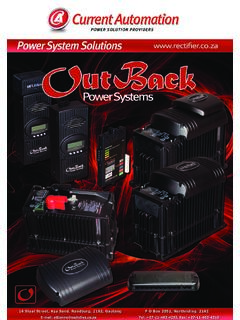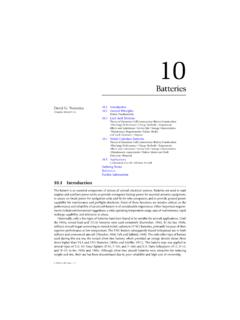Transcription of Batteries - Rectifier
1 BatteriesEnergy UnlimitedBatteries1. vrla technologyVRLA stands for Valve regulated Lead acid , which means the Batteries are sealed. Gas will escape through the safety valves only in case of overcharging or cell Batteries have exceptional leak resistance, and can be used in any Batteries are maintenance free for Sealed ( vrla ) AGM batteriesAGM stands for Absorbent Glass Mat. In these Batteries the electrolyte is absorbed into a glass-fibre mat between the plates by capillary action. As explained in our book Energy Unlimited , AGM Batteries are more suitable for short-time delivery of very high currents (engine starting) than gel Sealed ( vrla ) Gel batteriesHere the electrolyte is immobilized as gel. Gel Batteries in general have a longer service life and better cycle capacity than AGM Batteries .
2 4. Low Self-dischargeBecause of the use of lead calcium grids and high purity materials, Victron vrla Batteries can be stored during long periods of time without recharge. The rate of self-discharge is less than 2% per month at 20 C. The self discharge doubles for every increase in temperature with 10 vrla Batteries can therefore be stored during up to a year without recharging, if kept under cool Exceptional Deep Discharge RecoveryVictron vrla Batteries have exceptional discharge recovery, even after deep or prolonged should however be stressed that repetitive deep discharge and prolonged discharge have a very negative influence on the service life of all lead acid Batteries , Victron Batteries are no Battery discharging characteristicsThe rated capacity of Victron Batteries refers to a 10 hour discharge, in other words: a discharge current of 0,1 C.
3 The effective capacity decreases with increasing discharge current (see table 1). Please note that the capacity reduction will be even faster in case of a constant power load, such as an 1: Effective capacity as a function of discharge time. (the lowest row gives the maximum allowable 5 seconds discharge current)Our AGM deep cycle Batteries have excellent high current performance and are therefore recommended for high current applications such as engine to their construction, Gel Batteries have a lower effective capacity at high discharge currents. On the other hand, Gel Batteries have a longer service life, both under float and cycling Effect of temperature on service lifeHigh temperature has a very negative effect on service life. The service life of Victron Batteries as a function of temperature is shown in table 2: Design service life of Victron Batteries under float service8.
4 Effect of temperature on capacityAs is shown by the graph below, capacity reduces sharply at low temperatures. Temperatur ( C) Fig. 1: Effect of temperature on capacity9. Cycle life of Victron batteriesBatteries age due to discharging and recharging. The number of cycles depends on the depth of discharge, as is shown in figure 2. Depth of discharge Fig. 2: Cycle lifeNombre de cyclesAverage operating temperatureAGM Deep Cycle yearsGel DeepCycle yearsGel LongLife years 20 C / 68 F7 - 101220 30 C / 86 F4610 40 C / 104 F235 AGM Deep Cycle Gel deep Cycle Gel Long LifeDischarg time (constant current) EndvoltageVAGM Deep Cycle %Gel DeepCycle %Gel LongLife % 20 hours10,8105103102 10 hours10,8100100100 5 hours10,8959594 3 hours10,8828179 1 hours9,6666563 30 ,6524945 15 ,6423828 10 ,6362720 5 ,6271810 5 seconds8 C7 CCapacity (%)Number of cyclesBatteriesDeep Cycle AGM - Deep Cycle Gel - Long Life Gel10.
5 Battery charging in case of cycle use: the 3-step charge characteristicThe most common charge curve used to charge vrla Batteries in case of cyclic use is the 3-step charge characteristic, whereby a constant current phase (the bulk phase) is followed by two constant voltage phases (absorption and float), see fig. 3. Fig. 3: Three step charge curveDuring the absorption phase the charge voltage is kept at a relatively high level in order to fully recharge the battery within reasonable time. The third and last phase is the float phase: the voltage is lowered to standby level, sufficient to compensate for self discharge. Disadvantages of the traditional 3-step charge characteristic:During the bulk phase the current is kept at a constant andoften high level, even after the gassing voltage (14,34 V for a 12 V battery) has been exceeded.
6 This can lead to excessive gas pressure in the battery. Some gas will escape trough the safety valves , reducing service the absorption voltage is applied during a fixedperiod of time, irrespective of how deep the battery has been discharged previously. A full absorption period after a shallow discharge will overcharge the battery, again reducing service life. (a. o. due to accelerated corrosion of the positive plates) Research has shown that battery life can be increased by decreasing the float voltage to an even lower level when the battery is not in use. 11. Battery charging: longer battery life with Victron 4-step adaptive chargingVictron developed the adaptive charge characteristic. The 4-step adaptive chare curve is the result of years of research and Victron adaptive charge curve solves the 3 main problems of the 3 step curve:Battery Safe modeIn order to prevent excessive gassing, Victron has invented the Battery Safe Mode.
7 The battery Safe Mode will limit the rate of voltage increase once the gassing voltage has been reached. Research has shown that this will reduce internal gassing to a safe absorption timeBased on the duration of the bulk stage, the charger calculates how long it will keep the battery in absorption. If the bulk time is short, this means the battery was alrea-dy charged and the resulting absorption time will be short. A longer bulk time will also result in a longer absorption modeAfter completion of the absorption period the battery should be fully charged, and the voltage is lowered to the float or standby level. If no discharge occurs during the next 24 hours, the voltage is reduced even further and the battery goes into storage mode. The lower storage voltage reduces corrosion of the positive every week the charge voltage is increased to the absorption level for a short period to compensate for self discharge (Battery Refresh mode).
8 12. Battery charging in case of standby use: constant voltage float chargingWhen a battery is not frequently deeply discharged, a 2-step charge curve can be used. During the first phase the battery is charged with a limited current (the bulk phase). Once a preset voltage has been reached the battery is kept at that voltage (the float phase).This charge method is used for starter Batteries in vehicles, and in uninterruptible power supplies (UPS). egrahC020406080100120tnerruc egrahC////////Battery Safe FloatBattery Refresh StorageFigure 3: Four-step adaptive charge curve Calculated absorption time de chargegatloV 020406080100120 Courant de chargeCharge VoltageCharge CurrantFig. 4: Four-step adaptive charge curveCharge VoltageCharge CurrantBattery SafeCalculated absorption timeStorageFloatBattery RefreshPhone: +31 (0)36 535 97 00 Fax: +31 (0)36 535 97 40e-mail: Energy / De Paal 351351 JG Almere / The Netherlands13.
9 Optimum charge voltage of Victron vrla batteriesThe recommended charge voltage settings for a 12 V battery are shown in the following table Effect of temperature on charging voltageThe charge voltage should be reduced with increased temperature. Temperature compensation is required when the temperature of the battery is expected to be less than 10 C / 50 F or more than 30 C / 85 F during long periods of time. The recommended temperature compensation for Victron vrla Batteries is -4 mV / Cell (-24 mV / C for a 12 V battery). The centre point for temperature compensation is 20 C / 70 Charge currentThe charge current should preferably not exceed 0,2 C (20 A for a 100 Ah battery).The temperature of a battery will increase by more than 10 C if the charge current exceeds 0,2 C.
10 Therefore temperature compensation is required if the charge current exceeds 0,2 serviceCycle serviceNormalCycle serviceFastest rechargeVictron AGM Deep Cycle Absorption14,2 - 14,614,6 - 14,9 Float13,5 - 13,813,5 - 13,813,5 - 13,8 Storage13,2 - 13,513,2 - 13,513,2 - 13,5 Victron Gel Deep Cycle Absorption 14,1 - 14,4 Float13,5 - 13,813,5 - 13,8 Storage13,2 - 13,513,2 - 13,5 Victron Gel Long Life Absorption 14,0 - 14,2 Float13,5 - 13,813,5 - 13,8 Storage13,2 - 13,513,2 - 13,5 Table 3: Recommended charge voltages12 Volt Deep Cycle AGMG eneral Specification LxWxHWeightTechnology: flat plate AGMA rticle numberAhVmmkgTerminals: copperRated capacity: 10 hr discharge at 25 CBAT212120080 1212151x 98 x1014,1 Float design life: 7-10 years at 20 CBAT412350080 3512197x165x17012,5 Cycle design life200 cycles at 100% discharge*BAT412550080 5512239x132x23520400 cycles at 50% dischargeBAT412600080 6012258x166x23524900 cycles at 30% dischargeBAT412800080 8012350x167x18327 BAT41210108010012330x171x21532 BAT41212108012012410x176x22738 BAT41215108015012485x172x24047 BAT41220108020012522x238x2406512 Volt Deep Cycle GELG eneral Specification LxWxHWeightTechnology: flat plate GELA rticle numberAhVmmkgTerminals: copperRated capacity: 10 hr discharge at 25 CBAT412550100 5512239x132x23520 Float design life.




